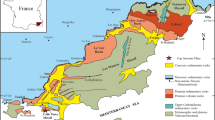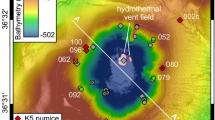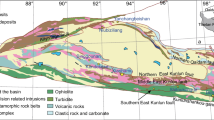Abstract
Microthermometry and Raman spectroscopy techniques are routinely use to constrain ore-fluids δ18O and molar proportions of anhydrous gas species (CO2, CH4, N2). However, these methods remain imprecise concerning the ore-fluids composition and source. Synchrotron radiation X-ray fluorescence allows access to major and trace element concentrations (Cl, Br and K, Ca, Fe, Cu, Zn, As, Rb, Sr) of single fluid inclusion. In this paper, we present the results of the combination of these routine and newly developed techniques in order to document the fluids composition and source associated with a Mesoarchaean lode gold deposit (Warrawoona Syncline, Western Australia). Fluid inclusion analyses show that quartz veins preserved records of three fluid inclusion populations. Early fluids inclusions, related to quartz veins precipitation, are characterized by a moderate to high Br/Cl ratio relative to modern seawater, CO2 ± CH4 ± N2, low to moderate salinities and significant base metal (Fe, Cu, Zn) and metalloid (As) concentrations. Late fluid inclusions trapped in secondary aqueous fluid inclusions are divided into two populations with distinct compositions. The first population consists of moderately saline aqueous brines, with a Br/Cl ratio close to modern seawater and a low concentration of base metals and metalloids. The second population is a fluid of low to moderate salinity, with a low Br/Cl ratio relative to modern seawater and significant enrichment in Fe, Zn, Sr and Rb. These three fluid inclusion populations point to three contrasting sources: (1) a carbonic fluid of mixed metamorphic and magmatic origin associated with the gold-bearing quartz precipitation; (2) a secondary aqueous fluid with seawater affinity; and (3) a surface-derived secondary aqueous fluid modified through interaction with felsic lithologies, before being flushed into the syncline. Primary carbonic fluids present similar characteristics than those ascribed to Mesoarchaean lode gold deposits. This suggests similar mineralization processes for mid- and Mesoarchaean lode gold deposits despite contrasting fluid–rock interaction histories. However, in regard to the protracted history documented in the Warrawoona Syncline, we question the robustness of the epigenetic crustal continuum model, as ore-fluid characteristics equally support an epigenetic or a polyphased mineralization process.














Similar content being viewed by others
References
Banks DA, Green R, Cliff RA, Yardley BWD (2000) Chlorine isotopes in fluid inclusions: determination of the origins of salinity in magmatic fluids. Geochim Cosmochim Acta 64:1785–1789
Bakker RJ (2003) Package FLUIDS 1. New computer programs for the analysis of fluid inclusion data and for modelling bulk fluid properties. Chem Geol 194:3–23
Bateman R, Hagemann S (2004) Gold mineralisation throughout about 45 Ma of Achaean orogenesis: protracted flux of gold in the Golden Mile, Yilgarn craton, Western Australia. Miner Depos 39:536–559
Bodnar RJ (1993) Revised equation and table for determining the freezing point depression of H2O–NaCl solutions. Geochim Cosmochim Acta 57:683–684
Böhlke JK, Irwin JJ (1992) Laser microprobe analysis of Cl, Br, I and K in fluid inclusions: implications for sources of salinity in some ancient hydrothermal fluids. Geochim Cosmochim Acta 56:203–226
Boiron MC, Essarraj S, Sellier E, Cathelineau M, Lespinasse M, Poty B (1992) Identification of fluid inclusions in relation to their host microstructural domains in quartz by cathodoluminescence. Geochim Cosmochim Acta 56:175–185
Boiron MC, Moissette A, Cathelineau M, Banks D, Monnin C, Dubessy J (1999) Detailed determination of paleofluid chemistry: an integrated study of sulphate-volatile rich brines and aqueo-carbonic fluids in quartz veins from Ouro Fino (Brazil). Chem Geol 154:179–192
Brown SM, Johnson CA (2003) Constraints on the composition of ore fluids and implications for mineralising events at the Cleo gold deposit, Eastern Goldfields Province, Western Australia. Aust J Earth Sci 50:19–38
Burrows DR, Wood PC, Spooner ETC (1986) Carbon isotope evidence for a magmatic origin for Archaean gold–quartz vein ore deposits. Nature 321:851–854
Cauzid J, Philippot P, Somogyi A, Simionovici A, Bleuet P (2004) Quantification of single fluid inclusions by combining synchrotron radiation induced mu-X-ray fluorescence and transmission. Anal Chem 76:3988–3994
Cauzid J, Philippot P, Somogyi A, Ménez B, Simionovici A, Bleuet P (2006) Standardless quantification of single fluid inclusion analysis using synchrotron radiation induced μ-X-ray fluorescence. Chem Geol (in press)
Collins PLF (1979) Gas hydrates in CO2-bearing fluid inclusions and the use of freezing data for estimation of salinity. Econ Geol 74:1435–1444
Collins WJ (1989) Polydiapirism of the Archean Mount Edgar Batholith, Pilbara Block, Western Australia. Precambrian Res 43:41–62
Collins WJ, Van Kranendonk MJ, Teyssier C (1998) Partial convective overturn of Archaean crust in the east Pilbara Craton, Western Australia: driving mechanisms and tectonic implications. J Struct Geol 20:1405–1424
Dubessy J (1984) Simulation des équilibres chimiques dans le système C–O–H: conséquences méthodologiques pour les inclusions fluides. Bulletins de Minéralogie 107:155–168
Dubessy J, Poty B, Ramboz C (1989) Advances in C–O–H–N–S fluid geochemistry based on micro-Raman spectrometric analysis of fluid inclusions. Eur J Mineral 1:517–534
Foriel J, Philippot P, Rey P, Somogyi A, Banks D, Ménez B (2004) Biological control of Cl/Br and low sulfate concentration in a 3.5-Gyr-old seawater from North Pole, Western Australia. Earth Planet Sci Lett 228(3–4):451–463
Frape SK, Fritz P (1987) Geochemical trends for groundwaters from Canadian shield. In: Saline water and gases in crystalline rocks, vol 33, pp 19–38
Fryer BJ, Kenich R, Hutchinson RW, Peirce MG, Rogers DS (1979) Archean precious metal hydrothermal systems, Dome mine, Abitibi greenstone belt: I. Patterns of alteration and metal distribution. Can J Earth Sci 16:421–439
Gebre-Mariam M, Groves DI, McNaughton NJ, Miicki EJ (1993) Multiple fluid sources and depositional mechanisms at the Archean mesozonal–epizonal Golden-Kilometre gold mine, Western Australia. In: Hach-Ali F, Tortes-Ruiz J, Gervilla F (eds) Current research in geology applied to gre deposits, pp 453–456
Goldfarb RJ, Groves DI, Gardoll S (2001) Orogenic gold and geologic time: a global synthesis. Ore Geol Rev 18:1–75
Groves D (1993) The crustal continuum model for late Archaean lode-gold deposits of the Yilgarn Block, Western Australia. Miner Depos 28:366–374
Groves DI, Phillips GN (1987) The genesis and tectonic control on Archaean gold deposits of the western Australian shield—a metamorphic replacement model. Ore Geol Rev 2:287–322
Hagemann SG, Ridley JR (1993) Hydrothermal fluids in epiand kataxonal crustal levels in the Archaean: implications for P-T-X-f evolution of lode-gold mineralisation. In: Williams PR, Haldane JA (eds) Kalgoorlie’93: an international conference on crustal evolution, metallogeny and exploration of the Eastern Goldfields, vol 54. Amt. Geol. SW. Organ. Record 1993, pp 123–130
Hickman AH (1983) Geology of the Pilbara Block and its environs. 1981/36, vol 127. Geological Survey of Western Australia, Perth, p 268
Hickman AH (2001) East Pilbara diapirism: new evidence from mapping. West Aust Geol Surv Rec 5:23–25
Hickman AH, Van Kranendonk MJ (2004) Diapiric processes in the formation of Archaean continental crust, East Pilbara Granite–Greenstone Terrane, Australia. In: Eriksson PG, Altermann W, Nelson DR, Mueller WU, Catuneanu O (eds) Tempos and events in Precambrian time. Elsevier, Amsterdam, pp 54–75
Huston D, Blewett R, Mernaugh T, Sun S-S, Kamprad J (2001) Gold deposits of the Pilbara Craton: results of AGSO Research, 1998–2000, vol 10, p 32
Hutchinson RW (1993) A multi-stage, multi-process genetic hypothesis for greenstone-hosted gold lodes. Ore Geol Rev 8:349–382
Irwin JJ, Roedder E (1995) Diverse origins of fluid in magmatic inclusions at Bingham (Utah, USA), Butte (Montana, USA), St Austell (Cornwall, UK), and Ascension Island (mid-Atlantic, UK), indicated by laser microprobe analysis of Cl, K, Br, I, Ba + Te, U, Ar, Kr, and Xe. Geochim Cosmochim Acta 59:295–312
Kenich R (1987) The stable isotope geochemistry of Au–Ag vein deposits in metamorphic rocks. In: Kyser TK (ed) Mineralogical Association of Canada Short Course, vol 13, pp 287–336
Kerrich R, Fryer BJ (1988) Lithophile-element systematics of Archaean greenstone belt Au–Ag vein deposits: implications for source processes. Can J Earth Sci 25:945–953
Kerrich R, Wyman D (1990) Geodynamic setting of mesothermal gold deposits: an association with accretionary tectonic regimes. Geology 18:882–885
Kloppenburg A, White SH, Zegers TE (2001) Structural evolution of the Warrawoona Greenstone Belt and adjoining granitoid complexes, Pilbara Craton, Australia: implications for Archaean tectonic processes. Precambrian Res 112:107–147
Mattey DP (1997) LaserPrep: an automatic laser-fluorination system for micromass ‘Optima’ or ‘Prism’ mass spectrometers, p 8
Mavrogenes JA, Bodnar RJ, Anderson AJ, Bajt S, Sutton SR, Rivers ML (1995) Assessment of uncertainties and limitations of quantitative elemental analysis of individual fluid inclusions using synchrotron X-ray fluorescence (SXRF). Geochim Cosmochim Acta 59:3987–3995
McCuaig TC, Kerrich R (1998) P-T-t-deformation-fluid characteristics of lode gold deposits: evidence from alteration systematics. Ore Geol Rev 12:381–453
McNaughton NJ, Barley ME, Cassidy KF, Golding SD, Groves DI, Ho SE, Hronsky JM, Sang JH, Turner JV (1990) Gold deposits of the Archaean Yilgam Block, Western Australia: nature, genesis and exploration guides. In: Ho SE, Groves, D.I., Bennett JM (eds) Carbon isotope studies, vol 20. Geol. Dep. Univ. Extension, Univ. Western Australia Publ., pp 246–251
Meinert LD (1993) Igneous petrogenesis and skarn deposits. In: Kirkham RV, Sinclair WD, Thorpe RI, Duke JM (eds) Mineral deposit modeling, vol 40. Geol. Assoc. Can., Spec. Pap., pp 569–583
Ménez B, Philippot P, Bonnin-Mosbah M, Simionovici A, Gibert F (2002) Analysis of individual fluid inclusions using synchrotron X-ray fluorescence microprobe: progress toward calibration for trace elements. Geochim Cosmochim Acta 66:561–576
Nesbitt BE, Muehlenbachs K (1989) Origins and movement of fluids during deformation and metamorphism in the Canadian Cordillera. Science 245:733–736
Philippot P, Ménez B, Chevalier P, Gibert F, Legrand F, Populus P (1998) Absorption correction procedures for quantitative analysis of fluid inclusions using synchrotron radiation X-ray fluorescence. Chem Geol 144:121–136
Phillips GN, Groves DI, Kerrich R (1996) Factors in the formation of the giant Kalgoorlie gold deposit. Ore Geol Rev 10:295–317
Roedder E (1972) Composition of fluid inclusions. In: Fleischer M (ed) Data of geochemistry, 6th edn. US Geological Survey professional paper 440JJ
de Ronde CEJ, Spooner ETC, de Wit MJ, Bray CJ (1992) Shear zone-related, Au quartz vein deposits in the Barberton greenstone belt, South Africa: field and petrographic characteristics, fluid properties and light stable isotope geochemistry. Econ Geol 87:366–402
Sherlock RL, Roth T, Spooner ETC, Bray CJ (1999) Origin of the Eskay Creek precious metal-rich volcanogenic massive sulfide deposit: fluid inclusion and stable isotope evidence. Econ Geol 94:803–824
Smithies RH, Champion DC, Cassidy KF (2003) Formation of Earth’s early Archaean continental crust. Precambrian Res 127:89–101
Solomon M, Gemmell JB, Zaw K (2004) Nature and origin of the fluids responsible for forming the Hellyer Zn–Pb–Cu, volcanic-hosted massive sulphide deposit, Tasmania, using fluid inclusions, and stable and radiogenic isotopes. Ore Geol Rev 25(1–2):89–124
Teyssier C, Collins WJ, Van Kranendonk MJ (1990) Strain and kinematics during the emplacement of the Mount Edgar Batholith and Warrawoona Syncline, Pilbara Block, Western Australia. In: Geoconferences (W.A.), Perth, Western Australia, pp 481–483
Thébaud N, Philippot P, Rey P, Brugger J, Kranendonk MV, Grassineau N (2006) Protracted fluid–rock interaction in the mid-Archaean and implication for gold mineralization: example from the Warrawoona Syncline (WA). Earth Planet Sci Lett (submitted)
Van Kranendonk MJ, Hickman AH, Smithies RH, Nelson DR, Pike G (2002) Geology and tectonic evolution of the Archaean North Pilbara Terrain, Pilbara Craton, Western Australia. Econ Geol 97(4):695–732
Van Kranendonk MJ, Smithies RH, Hickman AH, Bagas L, Williams IR, Farrell TR (2004) Event stratigraphy applied to 700 million years of Archaean crustal evolution, Pilbara Craton, Western Australia. In: Technical papers 2003-04 annual review. Geological Survey of Western Australia, Perth, pp 49–61
Viljoen M (1984) Archaean gold mineralization and Komatiites in Southern Africa. In: Foster RP (ed) Gold’82: the geology, geochemistry and genesis of gold deposits. A A Balkema, Rotterdam
Yardley BWD, Graham JT (2002) The origins of salinity in metamorphic fluids. Geofluids 2:249–256
Zaw K, Hunns SR, Largea RR, Gemmella JB, Ryanb CG, Mernagh TP (2003) Microthermometry and chemical composition of fluid inclusions from the Mt Chalmers volcanic-hosted massive sulfide deposits, central Queensland, Australia: implications for ore genesis. Chem Geol 194:225–244
Zegers TE, Barley ME, Groves DI, McNaughton NJ, White SH (2002) Oldest gold: deformation and hydrothermal alteration in the Early Archean Shear Zone-hosted Bamboo Creek Deposit, Pilbara, Western Australia. Econ Geol 97(4):757–773
Zheng YF (1993) Calculation of oxygen isotope fractionation in anhydrous silicate minerals. Geochim Cosmochim Acta 57:1079–1091
Author information
Authors and Affiliations
Corresponding author
Additional information
Communicated by J. Hoefs
Rights and permissions
About this article
Cite this article
Thébaud, N., Philippot, P., Rey, P. et al. Composition and origin of fluids associated with lode gold deposits in a Mesoarchean greenstone belt (Warrawoona Syncline, Pilbara Craton, Western Australia) using synchrotron radiation X-ray fluorescence. Contrib Mineral Petrol 152, 485–503 (2006). https://doi.org/10.1007/s00410-006-0116-1
Received:
Accepted:
Published:
Issue Date:
DOI: https://doi.org/10.1007/s00410-006-0116-1




